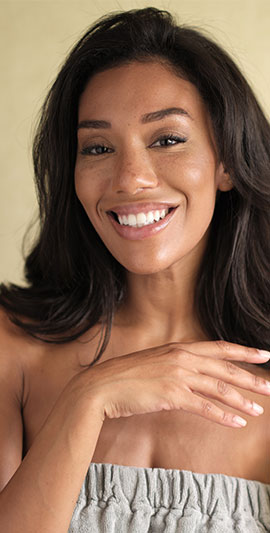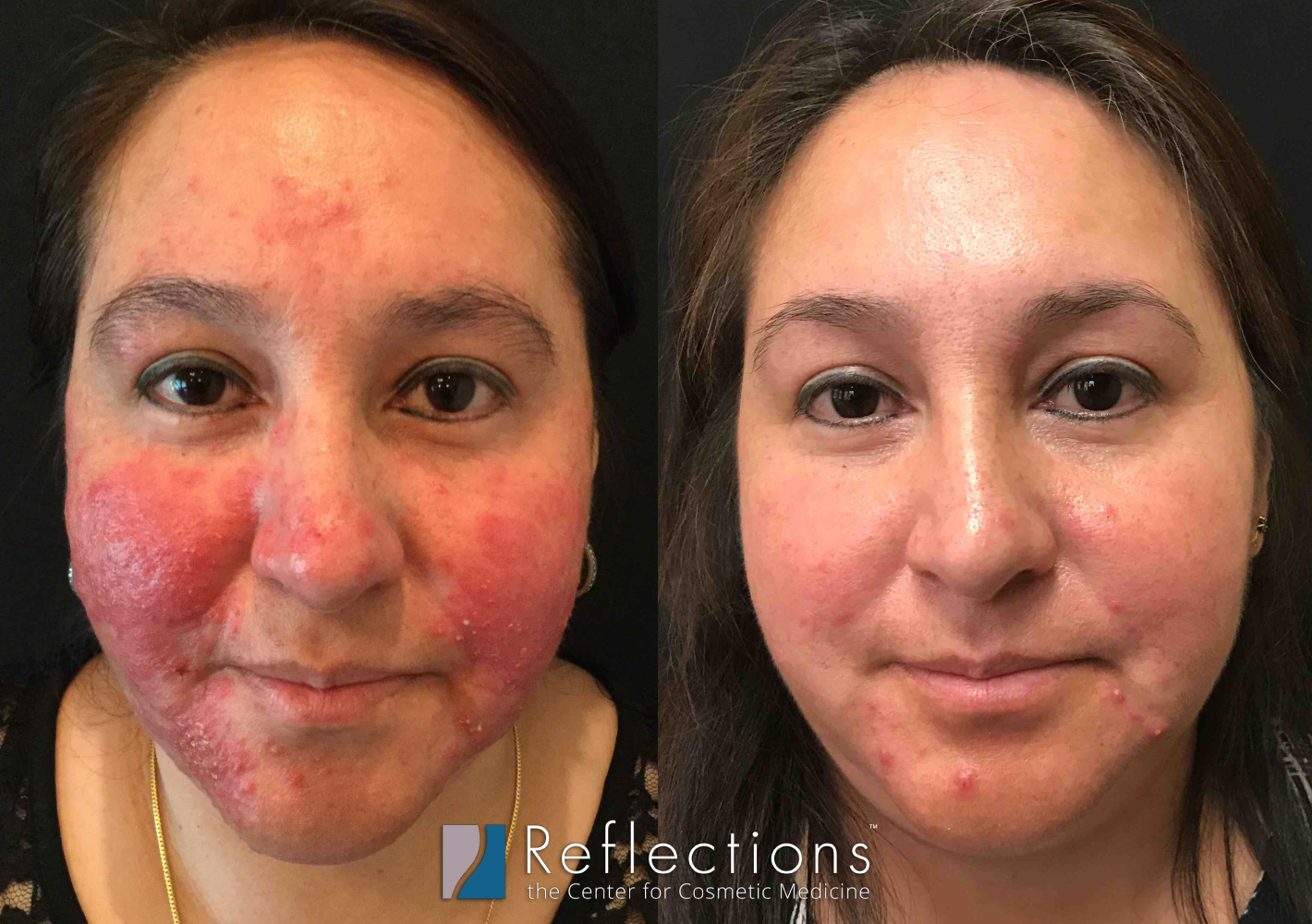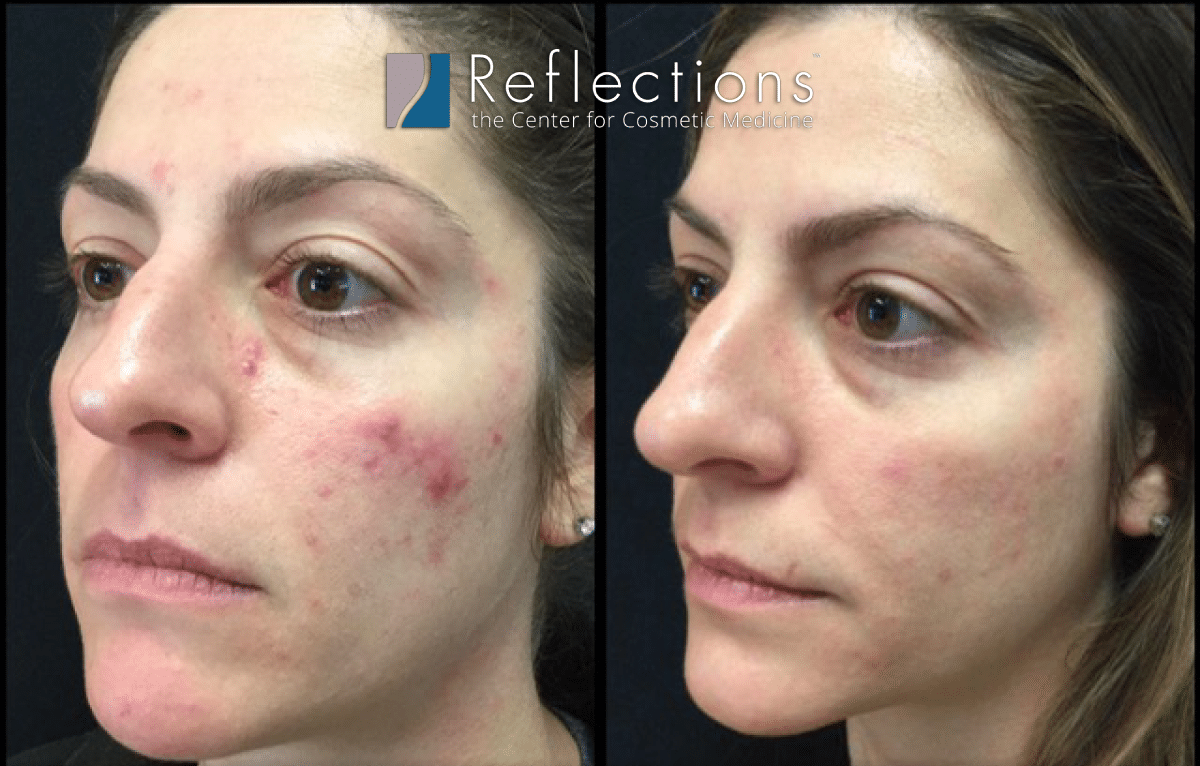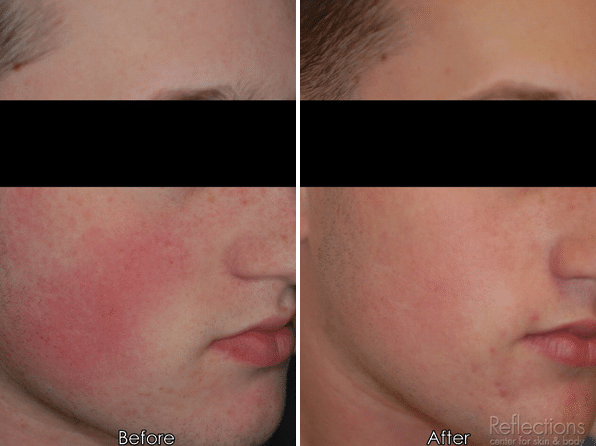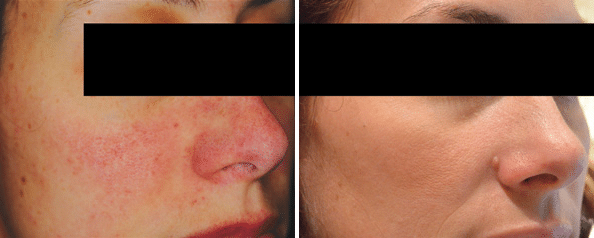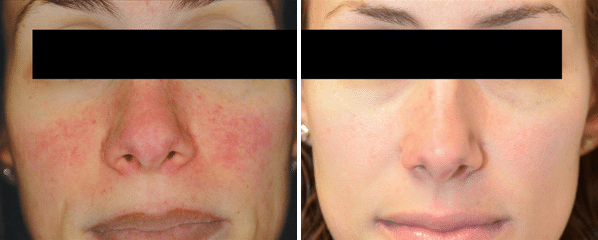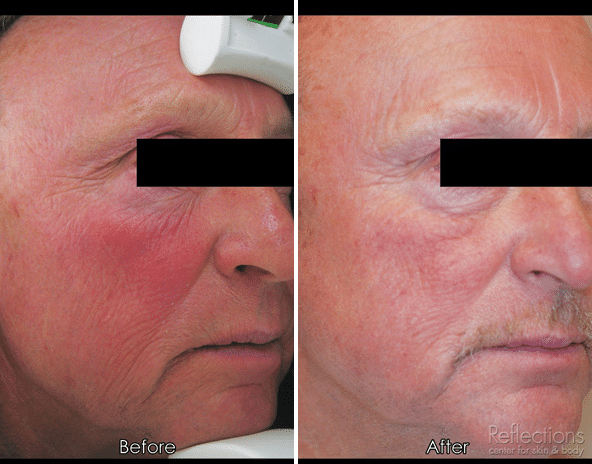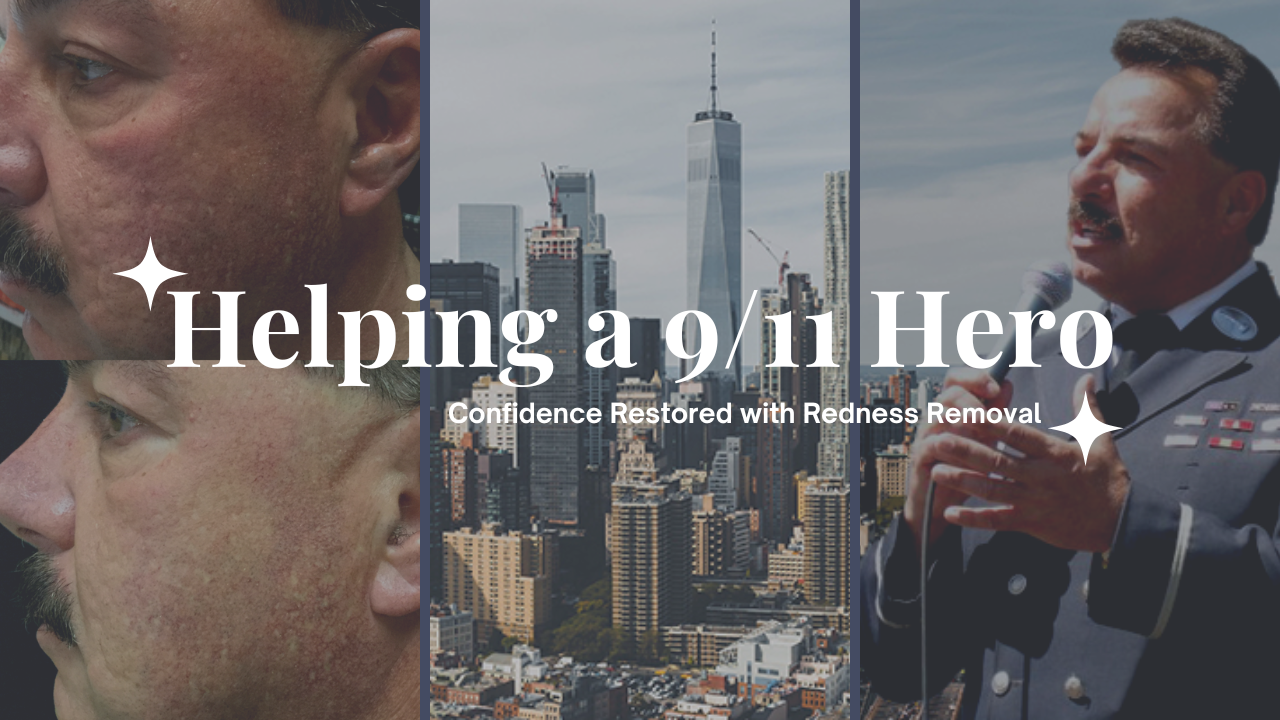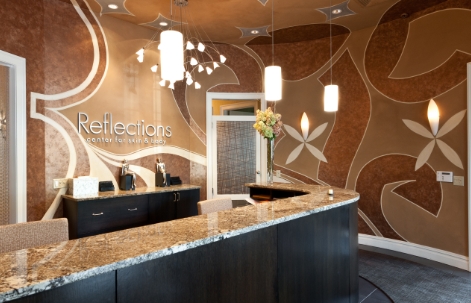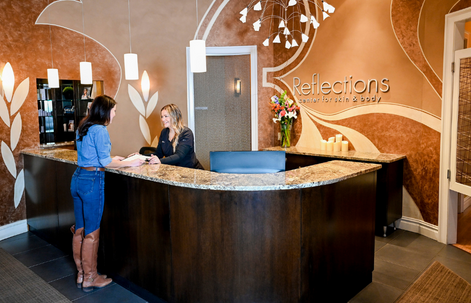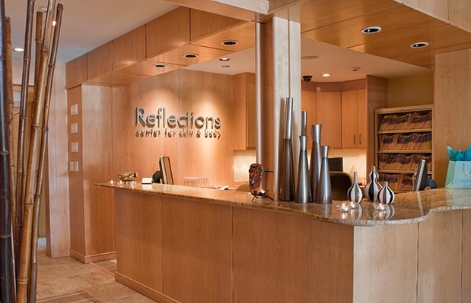Persistent facial redness can impact your confidence in work and social situations. Often rosacea is so red and inflamed that makeup can’t camouflage it very well. Most patients who suffer from rosacea say it dramatically affects their lives. New technologies have given us the ability to reduce and, in some cases, completely eliminate the signs and symptoms of rosacea.
Top Asked Questions For Rosacea
- Do I have rosacea?
Red skin is not just a sign of rosacea. Other skin conditions like sebaceous hyperplasia, broken capillaries, spider veins, lupus, eczema, psoriasis, and allergic reactions (dermatitis) can sometimes be mistaken for rosacea. Below, you will find a list and pictures of rosacea symptoms, which may help you to determine whether rosacea is a possible diagnosis for your symptoms. Rosacea can be difficult to diagnose by yourself so it is best to see a specialist who can properly rule out other causes and provide appropriate care. We specialize in treating patients who have already been diagnosed with rosacea, tried traditional treatment methods, and found their rosacea is particularly stubborn or advanced in nature.
- Who get rosacea?
Approximately 16 million people in the United States have rosacea. It most often affects adults between the ages of 30 and 60. Rosacea is more common in women (particularly during menopause) than men. Although rosacea can develop in people of any skin color, it tends to occur most frequently and is most apparent in people with fair skin.
- Is rosacea inherited from your parents?
It is believed that the predisposition to rosacea is inherited through genes, but that the onset of rosacea is triggered by environmental factors. This means that anyone, regardless of whether their parents or family members experienced rosacea symptoms, can develop rosacea. In a survey by the National Rosacea Society, 33 percent of rosacea sufferers reported having at least one parent of Irish heritage and 26 percent had a parent of English descent. Those of Scandinavian, Scottish, Welsh, or Eastern European descent also appear to be at an elevated risk for developing rosacea. However, individuals of all races and ethnicities have developed rosacea.
What is Rosacea?
Rosacea is a chronic (or long-term) skin disease that affects sensitive skin and sometimes the eyes. Rosacea symptoms often include flare-ups of visible blood vessels for weeks or months which then reduce or fade altogether for a while. Rosacea patients are often misdiagnosed with an allergic reaction or acne, especially when it causes small pus-filled bumps more than thickened skin. Rosacea affects the face; other upper body parts are rarely involved.
When left untreated, each new flare tends to be worse than the last, making this a progressive skin condition. Left untreated, it can cause thickening of the skin and knobby bumps on the nose. Past methods to treat rosacea have traditionally focused on reducing the symptoms of rosacea and using a gentle skin care routine to keep the condition from worsening over time. However, new research and treatments are helping us better prevent new flares.
Causes & Symptoms of Rosacea
We don’t know exactly what causes rosacea, but it usually strikes people in their thirties and forties. It can also irritate the eyes and other parts of the body and tends to run in families. Middle-aged women with fair skin are the most commonly affected group. Early intervention is key when dealing with rosacea and with an early diagnosis and treatment, it is possible to stop the condition from worsening.
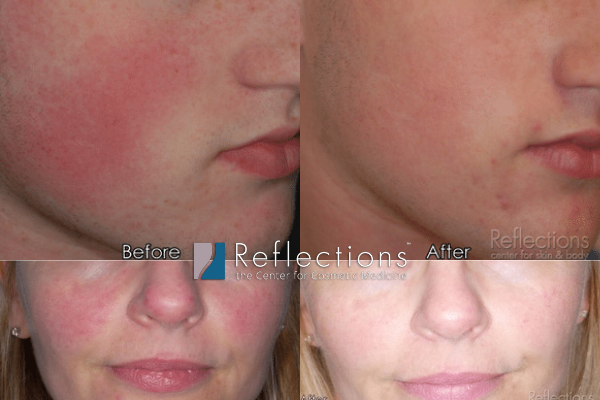
Frequently Flushing Of the Center of the Face
Flushing or red patches may appear on the forehead, nose, cheeks, and chin, occurring in the earliest stage of rosacea. The flushing often is accompanied by a burning sensation, particularly when creams or cosmetics are applied to the face. Sometimes the face is swollen slightly. Lasers work very well in these early stages to clear away the redness, but you also want a doctor who is going to help you slow down the progression of rosacea at this point so that you minimize the severity of symptoms long-term.
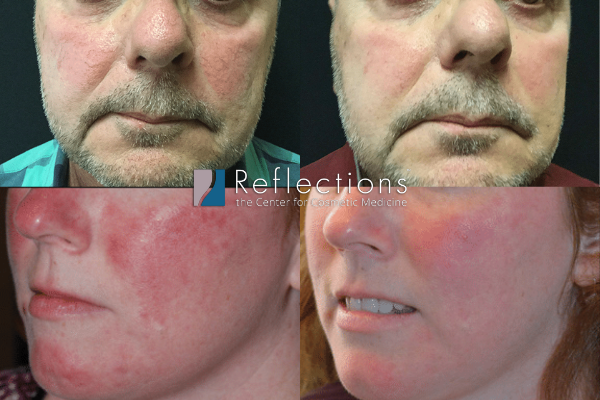
Vascular Rosacea
A condition called vascular rosacea causes persistent flushing and redness. Blood vessels under the skin of the face may dilate (enlarge), showing through the skin as small red lines. This is called telangiectasia and is often confused with broken capillaries and spider veins. The affected skin may be swollen slightly and feel warm.
At this point, rosacea gets harder to fuller clear, although there have been some advances in rosacea treatment in recent years that offer some hope – such as MicroBotox and the newly updated VBeam Prima (perfecta is the older model of this laser).
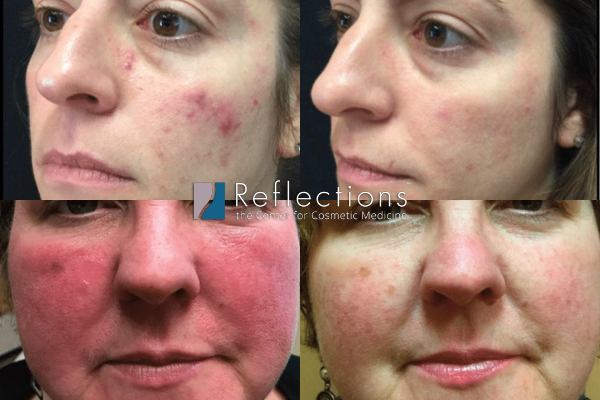
Inflammatory Rosacea
A condition called inflammatory rosacea causes persistent redness and papules (pink bumps) and pustules (bumps containing pus) on the skin. Eye inflammation and sensitivity, as well as telangiectasia, also may occur.
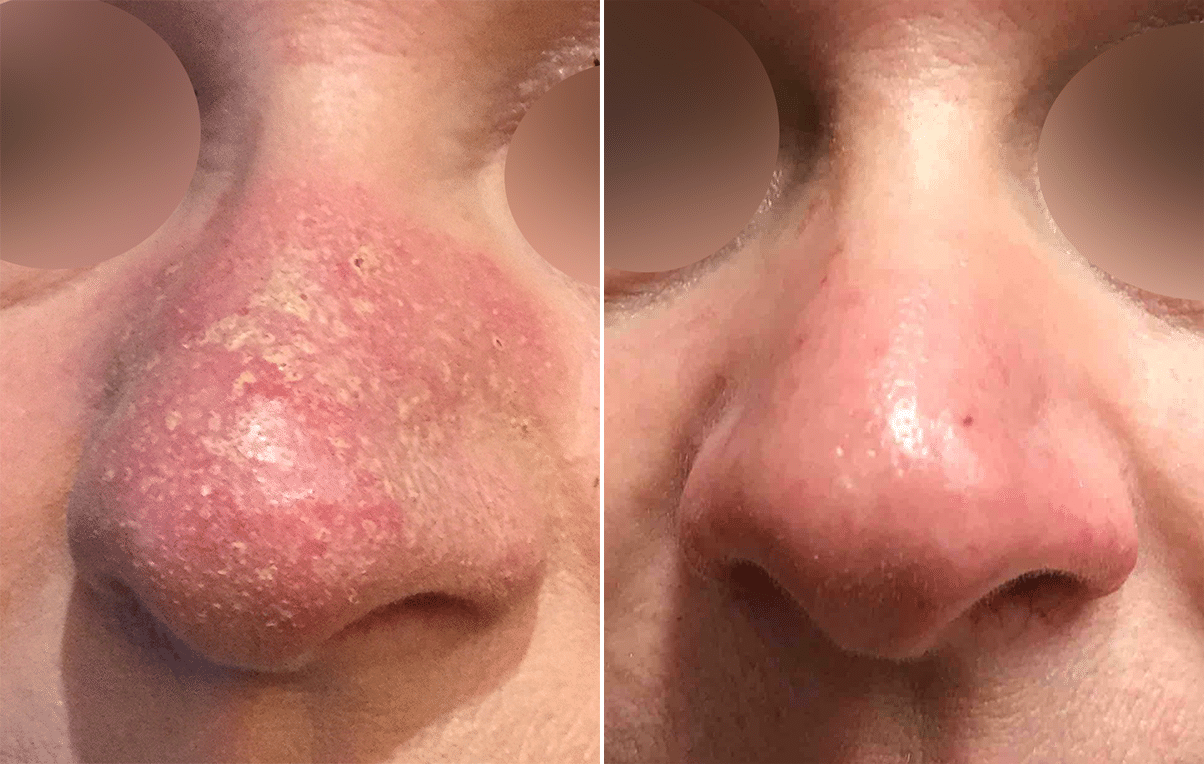
Rhinophyma
In the most advanced stage of rosacea, the skin becomes a deep shade of red and inflammation of the eye is more apparent. Numerous telangiectasia are often present, and nodules in the skin may become painful. A condition called rhinophyma, characterized by an enlarged, bulbous and red nose also may develop in some men.
Our Favorite Treatments for Rosacea
Flushing can be tricky to get under control, even though it’s the very first symptom for many patients.
At this stage, it’s important to pair lasers and treatment technologies with at-home prescription care to help keep any results you achieve.
Vbeam Laser
Vbeam is specifically designed to target redness in the skin caused by red blood cells, which is what flushing is. Flushing is essentially the blood vessels near the skin overgrowing and dilating, allowing more of the fresh blood in these vessels to be seen through the skin.
Since the Vbeam laser can target just those vessels and remove a portion of them with each treatment, you get great results that are very safe on all skin types without the risk of any surrounding tissue being damaged or long downtime. It’s also pretty cost-effective, which patients love. Most patients require a series of treatments with occasional maintenance.
MicroBotox
However, most practices don’t understand how to use MicroBotox in the context of managing rosacea as a disease and ongoing maintenance. If you’re interested in MicroBotox, we are happy to become your rosacea doctors and help you with the full scale of treatment.
Prescription Medications
Prescription medications are very important for keeping flushing at bay and keeping rosacea under control. The most common ones we use for patients with flushing are Rhofade and Mirvaso.
VBeam Laser
The newly upgraded VBeam Prima laser is really our favorite laser for removing redness, including both flushing and broken capillaries. It is the safest and most effective, and it’s very cost effective and has very little downtime or impact on your lifestyle.
IPL: Intense Pulsed Light
We stopped using the IPL for rosacea many years ago when VBeam came out because VBeam is so much more precise. VBeam offers better customization of its settings, making the IPL a much inferior treatment option for the vast majority of patients.
Skin Classic
Skin Classic is a high frequency radiofrequency device that can be used to treat individual thread veins or broken capillaries. It does carry a higher risk of scarring and complications, so we almost always defer to VBeam for this reason.
VBeam Laser
VBeam laser is the best at treating redness in the skin, which includes individual pimples or pustules, which are red and inflamed.
Topical Prescription Medications
Prescription medications are very important for controlling these rosacea breakouts and getting skin to stay clear. Our doctors will write you prescriptions for your rosacea, most of which are covered by insurance.
Rhinophyma has 2 stages – a preliminary stage where the nose is red with broken capillaries and inflamed, and then it begins to grow and distort in shape over time. We do not treat those patients who have full-blown rhinophyma, as this requires a highly specialized surgical intervention.
For a Red Nose with Broken Capillaries
VBeam laser and prescription medications can help manage the early stages of rhinophyma and slow its progression. We are happy to provide this kind of care for patients who are in this stage.
Rhinophyma Surgery
Once rhinophyma has progressed to the point where excess layers of skin are forming and starting to make the nose appear larger and misshapen, we refer out for treatment, which generally involves surgery.

View More Rosacea Treatment Before & After Images
More Before & Afters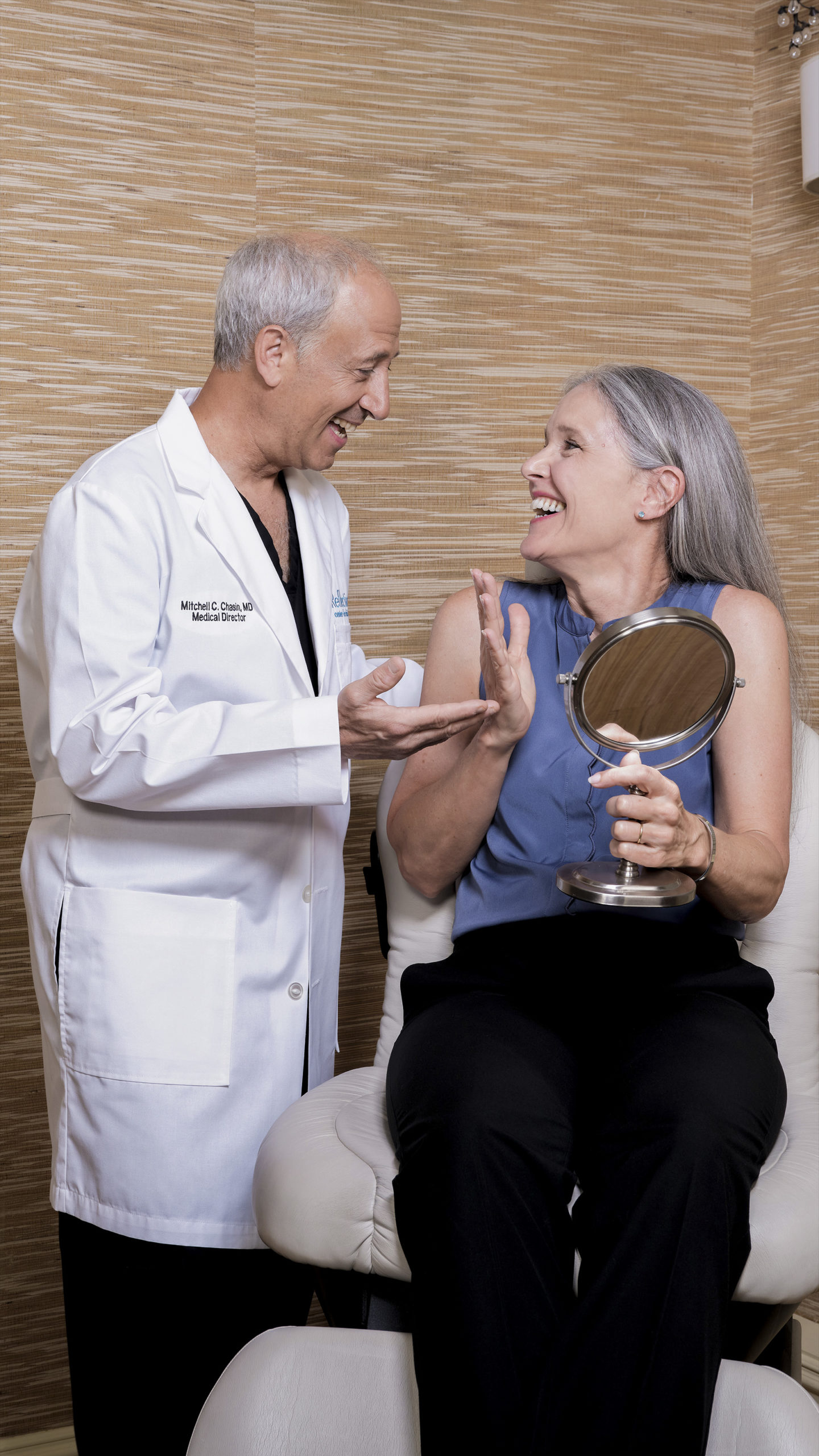

Discover Fast and Effective Treatment for Rosacea and Facial Redness
Rosacea and skin redness can be frustrating for those who live with it on a daily basis. What’s worse is that it can cause painful side effects. At Reflections, our cosmetic physicians are dedicated to discovering the root cause of your skin symptoms, so that we can effectively and efficiently treat these conditions at the source. We are constantly researching the newest medical innovations to bring the best treatments to our practice. Our goal is to treat every patient who comes into our office with compassionate and knowledgeable care.
Schedule a Complimentary Skin Consultation
Your complimentary skin consultation will start with an examination and medical history, which will allow us to properly diagnose you. From there, we’ll create a treatment plan that suits your budget, skin type, and lifestyle, so that you can enjoy clear skin, fast.
Call our offices at (732) 356-1666 to schedule your complimentary skin consultation today. We look forward to helping you achieve healthy skin and feel more confident about your appearance!
Frequently Asked Questions About Rosacea
- Who gets rosacea?
Approximately 16 million people in the United States have rosacea. It most often affects adults between the ages of 30 and 60. Rosacea is more common in women (particularly during menopause) than men. Although rosacea can develop in people of any skin color, it tends to occur most frequently and is most apparent in people with fair skin5.
- Is rosacea inherited from your parents?
It is believed that the predisposition to rosacea is inherited through genes, but that the onset of rosacea is triggered by environmental factors. Meaning that anyone, regardless of whether their parents or family members experienced rosacea symptoms, may develop rosacea.
In a survey by the National Rosacea Society, 33 percent of rosacea sufferers reported having at least one parent of Irish heritage, and 26 percent had a parent of English descent. Those of Scandinavian, Scottish, Welsh or eastern European descent also appear to be at an elevated risk for developing rosacea. However, individuals of all races and ethnicities have developed rosacea.
- What are the causes of rosacea?
Doctors do not know the exact cause of rosacea but believe that some people may inherit a tendency to develop the disorder. People who blush frequently may be more likely to develop rosacea. Some researchers believe that rosacea is a disorder where blood vessels dilate too easily, resulting in flushing and redness. The National Rosacea Society notes that scientific research points towards an overabundance of a certain type of mite, demodex, triggering an immune response that sets off rosacea. Demodex mites occur naturally on the skin of all humans, but seem to grow in much larger numbers on the skin of those affected by rosacea.
- What triggers rosacea?
Factors that cause rosacea to flare up in one person may have no effect on another person. Although the following factors have not been well-researched, some people claim that one or more of them have aggravated their rosacea: heat (including hot baths), strenuous exercise, sunlight, wind exposure, very cold temperatures, hot or spicy foods and drinks, alcohol consumption, menopause, emotional stress, and long-term use of topical steroids on the face.
Patients affected by pustules may assume they are caused by bacteria, but researchers have not established a link between rosacea and bacteria or other organisms on the skin, in the hair follicles, or elsewhere in the body.
- Is rosacea acne?
Rosacea is not acne, although many times it is mistaken for acne. Like acne, rosacea causes red, pus-filled bumps. However, acne does not tend to cause the widespread redness that rosacea does.
- How is the eye affected in ocular rosacea?
In addition to skin problems, up to 50 percent of people who have rosacea have eye problems caused by the condition. Typical symptoms include redness, dryness, itching, burning, tearing, and the sensation of having sand in the eye. The eyelids may become inflamed and swollen. Some people say their eyes are sensitive to light and their vision is blurred or otherwise impaired.
Doctors usually treat the eye problems of rosacea with oral antibiotics, particularly tetracycline, doxycycline or topical medicines. People who develop infections of the eyelids must practice frequent eyelid hygiene. The doctor may recommend scrubbing the eyelids gently with diluted baby shampoo or an over-the-counter eyelid cleaner and applying warm (but not hot) compresses several times a day. When eyes are severely affected, doctors may prescribe steroid eye drops.
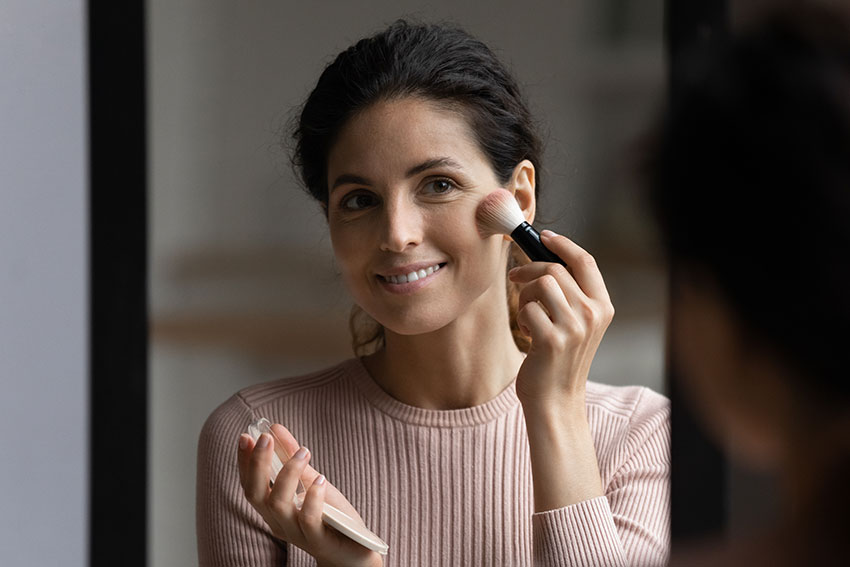
Blog
Laser Treatment for Rosacea: What is It and How Does It Help?
Pink cheeks are a sign of youth and beauty, which is why so many makeup...
Read More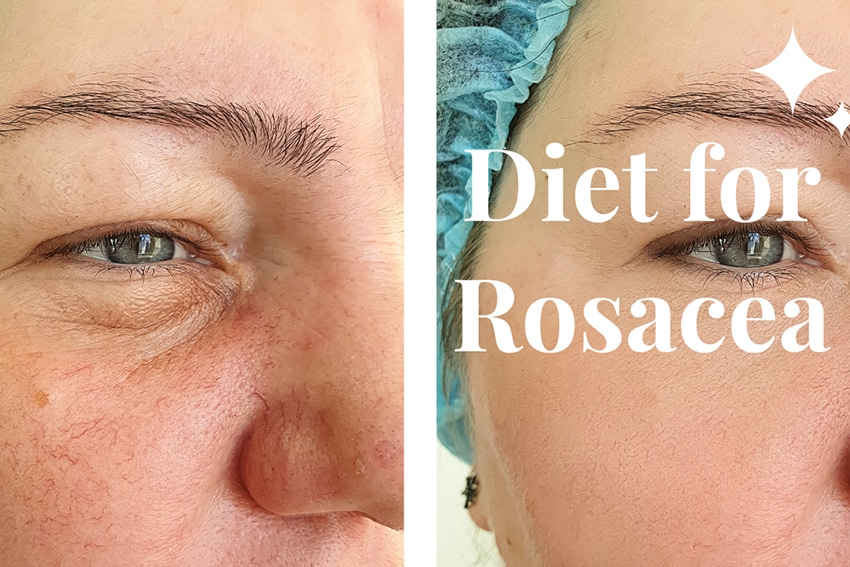
Blog
Nutritious diet may combat rosacea
Most people know that eating a nutritious diet can help them lose weight and...
Read More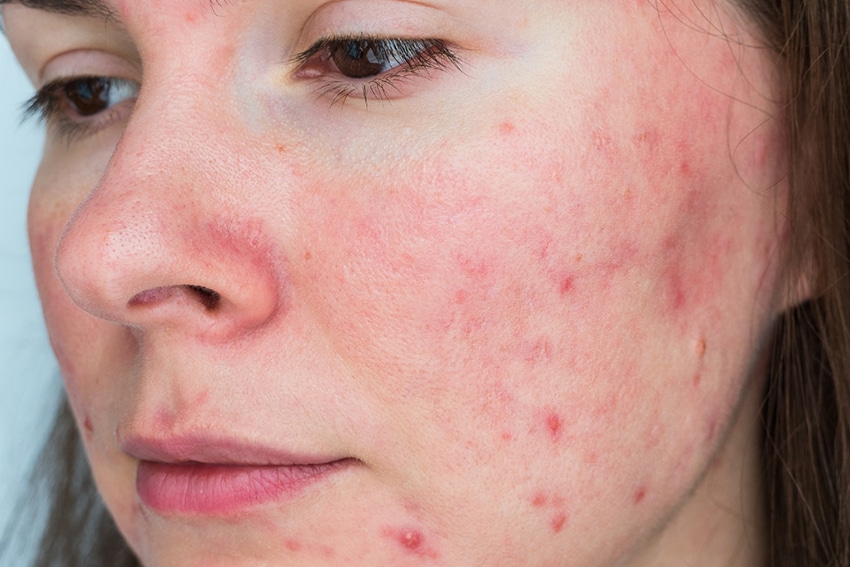
Blog
Understanding Rosacea: History of Treatments
In our video series, Dr. Chasin gives us a look into rosacea treatment for his...
Read MoreSchedule Your Free Consultation
With One Of Our Physicians
Schedule Now
Sources:
- Adam M. Rotunda, Anand R. Bhupathy, Thomas E. Rohrer; The new age of acne therapy: Light, lasers, and radiofrequency; Published online: 12 Jul 2009; pages 191-200
- Stephen R. Tan, MD, FRCPCa, Whitney D. Tope, MPhil, MD; Pulsed dye laser treatment of rosacea improves erythema, symptomatology, and quality of life; Journal of the American Academy of Dermatology; Volume 51, Issue 4, October 2004, Pages 592–599
- NEUHAUS, I. M., ZANE, L. T. and TOPE, W. D. (2009), Comparative Efficacy of Nonpurpuragenic Pulsed Dye Laser and Intense Pulsed Light for Erythematotelangiectatic Rosacea. Dermatologic Surgery, 35: 920–928. doi: 10.1111/j.1524-4725.2009.01156.
- Chia-Lun Chou & Ying-Yi Chiang; Moderate rhinophyma successfully treated with a Smoothbeam laser; Journal of Dermatological Treatment; Volume 23, Issue 2, 2012
- Lynn Drake, MD; Rosacea Now Estimated to Affect at Least 16 Million Americans; Rosacea Review, Winter 2010 Issue
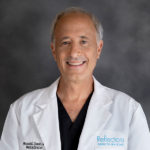
Dr. Mitchell Chasin
Dr. Mitchell Chasin is a Cosmetic & Laser Physician at Reflections Center. Dr. Chasin believes strongly that the best cosmetic physicians are those who are dedicated to mastering their craft through continuing education and collaboration with the industry’s top doctors.



